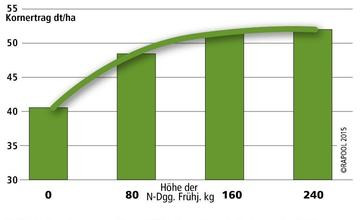How the autumn developed is influencing spring fertilization
Rapeseed is a real growth monster in autumn, if the conditions and technology are favorable. A luxuriant rapeseed can develop till end of the year between 2 – 3 kg green biomass/m², which means that the rapeseed canopy has already taken up between 100 - 150 kg N/ha (based on the fresh mass). This is more than necessary, since the recommended amount is just 1 kg biomass/m² or 50 kg N/ha.
But what does it mean for the spring fertilization? Based on long-term fertilization trials with rapeseed, we recognize that the plants react moderate on an increased nitrogen fertilization.

The graph 1 present results based on several trials with strong developed rapeseed in autumn. It is clear to see that above 150 kg N/ha there no stronger yield effects visible.
The fresh mass weighing is an easy tool to assess the rapeseed canopies before winter. The process should be made by the end of autumn and be repeated until the beginning of vegetation in the case of heavy leaf losses during winter in order to calculate the N saving potential, based on the average value of the autumn and spring weighing.
For this purpose, one square meter of rapeseed is harvested, weighed and the amount of N contained is determined using appropriate instructions or the RAPOOL N-scale. For weak rapeseed fields with less than 50 kg N uptake in autumn, slight increase for the N fertilization in spring are recommended.
With the help of Yara ImageIT the nitrogen of rapeseed can also be determined relatively easily using photos of the plant population in autumn and at the beginning of vegetation. To do this, it is enough to take several photos of the crop to be tested with a smartphone and to analyze them in the application via upload. The service is specially designed for smartphones and tablets and free of charge.
From the amount above the minimum value (50 kg N/ha), 70 % of this nitrogen quantity (for example: 2 kg biomass means 100 kg N/ha -> 50 * 0,7 -> approx. 35 kg N/ha) can be considered for the spring fertilization and offers an attractive potential for reduced N fertilization.
Rapool established already many years ago a special production technology trial network for sowing dates, different fertilization intensities, respectively various soil preparation.
Based on the political pressure regarding nitrogen fertilization and in order to offer further alternatives for a higher nitrogen efficiency, we set up N-trials with two different intensities: low (120 kg N/ha) and intensive (170 kg N/ha). The graph 2 is presenting a compact summary of the last 5 years, based on 2 different sowing dates and 3 locations. Based on the challenging climate conditions in the last years and improved hybrids (vigorous autumn development + better plant health (TuYV)) we can recognize that the individual nitrogen effect is pretty low.
Our summary shows clearly:
1. Lower nitrogen fertilization -> higher oil content: + 0,6 %
a. That means a higher price: 4 €/t
2. Lower nitrogen fertilization (- 50 kg N/ha) -> saving costs: + ca. 32 €/ha
3. We save one drive over the field: + 7,3 €/ha
In total a lower nitrogen fertilization compensates around 50 €/ha = 1,35 dt/ha, this corresponds to the higher yield potential of the intensive fertilization with 170 kg N/ha.

Finally, we can summarize, that rapeseed is able to reach also with a lower nitrogen fertilization an attractive yield production. Based on our own trial network for nitrogen efficiency we can present, that the new candidates with vigorous autumn development and strong plant health (including TuYV resistance) can compensate a lower fertilization in spring. Especially in the last two years (2018 + 2019) we observe that high yielding hybrids with a strong autumn growth and well-developed root system are able to establish a promising plant architecture in early spring before the first heat wave, respectively drought occurs.
The continuous increase in yield offer the potential for cost saving in the technology, but it remains: a strong developed rapeseed in autumn offer not only the chance to optimize the nitrogen fertilization in spring, it is the major key for a high yield production in summer.
René Brand
Rapool International


